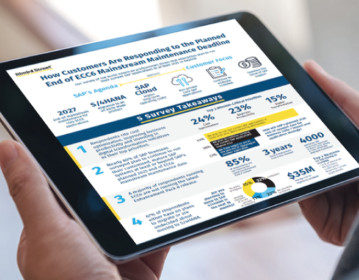
The oft-quoted Michael Porter has stated that the essence of strategy is knowing ‘what not to do!’ ─ it is as important as knowing what to do.
How does this apply to maintenance for SAP and IT roadmap strategy?
In a November 2019 survey conducted by Rimini Street, 79% of licensees said that they have no plans to ‘rip and replace’ their SAP Business Suite/ECC6 software instances which have been customized to meet business needs.2
These licensees generally pay 22% of their license costs for vendor support for their SAP applications,1 In addition to this, they also continue to spend on custom code maintenance and self-support. By moving to independent, third-party support, annual maintenance fees for SAP applications are slashed by 50%. While these are direct savings that can be achieved immediately by moving to third-party support, they still only represent the tip of the iceberg of savings.
The remaining part of the iceberg of savings comes mainly through other activities:
- Avoiding forced updates to their SAP license to maintain full support
- Avoiding costs and bandwidth of maintaining custom code
- Avoiding costs and bandwidth of self-support
- Avoiding or deferring a forced upgrade (to S/4HANA) to maintain full support
Forced updates to SAP Applications
SAP continues to provide updates, patches, add-ons, and new versions to its licensees. However, not all these updates or patches make sense for all enterprises. Many of them may provide little overall value but incur significant cost and bandwidth to apply, test, and implement. This often forces system downtime, too.
Evaluating which patches and updates are truly necessary for the business and applying only those, SAP licensees can save significant costs and reduce the overall burden of maintenance for their SAP products.
An example is CF Industries and its move to independent, third-party support in 2016. As a result, total annual maintenance and support costs for their SAP platform has been reduced by 79%, with projected savings of more than $25 million over a 10-year period. Of that, a significant portion is expected to come from avoiding five potential updates over ten years ─ funds that are being redirected to innovations in contract labor management, business intelligence, and mobile applications.3
Another licensee now using independent, third-party support for SAP products says, “The savings count, but it’s also about the time. We would spend two to three months in the summer on patches. If we weren’t on the latest patch and had an issue, SAP would always tell us that was the problem. Now we save all that time.”
Independent, third-party support for SAP products has concrete savings on actual support fees ─ the tip of the savings iceberg. Strategic IT leaders with tight IT budgets, limited team bandwidth, and a growing list of critical IT projects to deliver can avoid SAP updates by signing up for independent, third-party support for SAP products.
This magnitude of spend could fund significant innovation for the company.
Hence, asking “What not to do?” could be the most important question for SAP licensees.
2 How SAP Customers Are Responding to the Planned End of ECC6 Mainstream Maintenance Deadline
3 Profiles of 12 Rimini Street Clients Using Business-Driven IT Roadmaps for Greater Success
4 Rimini Street S/4HANA Calculator (Validated by Vinnie Mirchandani, Author: SAP Nation, Leading Industry Analyst Inputs)



